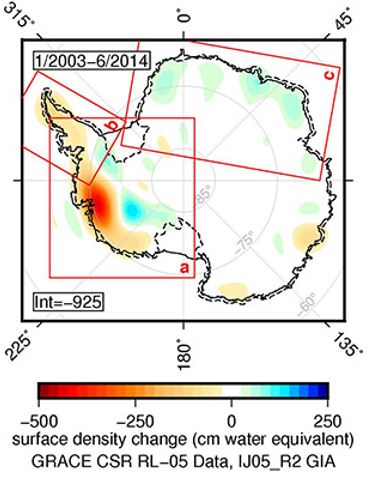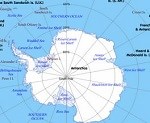Antarctica’s ice is melting at an accelerating rate. Simulations of events dating back millions of years have led scientists to conclude that sea levels could rise by nearly 3 metres (nearly 10ft) by 2100, unless drastic action is taken to reduce emissions.
During the last ten years, Antarctica’s huge ice sheet lost twice as much ice on its western portion compared to what it built up in the east, Princeton University scientists informed in a paper published in the academic journal Earth and Planetary Science Letters.
They came to the conclusion that Antarctica’s ice cap is melting much faster than experts had thought.

During the past decade, Antarctica’s massive ice sheet lost twice the amount of ice in its western portion compared to what it accumulated in the east. (Image: Princeton)
Frederik Simons, a Princeton associate professor of geosciences, and colleagues ‘weighed’ Antarctica’s ice sheet using gravitational satellite data. They found that from 2003 to 2014, the ice sheet had lost 92 billion tons of ice annually.
Mile-high ice block over Manhattan
This ice loss, if placed on the Island of Manhattan, would be more than one mile high, or five times the height of the Empire State Building.
Most of that loss came from West Antarctica, which is the smaller of the continent’s two main regions, and adjoins the Antarctic Peninsula that winds northward to South America.
Ice loss from West Antarctica’s unstable glaciers doubled from 2008 to 2014, from 121 billion tons of ice to 242 billion tons, the authors wrote.
In East Antarctica, the continent’s much bigger and overall more stable region, the ice sheet thickened over the same period. However, it only built up half the amount that was lost in the west.
Prof. Simons said:
“We have a solution that is very solid, very detailed and unambiguous. A decade of gravity analysis alone cannot force you to take a position on this ice loss being due to anthropogenic global warming.”
“All we have done is take the balance of the ice on Antarctica and found that it is melting — there is no doubt.”
“But with the rapidly accelerating rates at which the ice is melting, and in the light of all the other, well-publicized lines of evidence, most scientists would be hard pressed to find mechanisms that do not include human-made climate change.”
Ice melting faster than previously thought
Compared with previous studies, the Princeton data shows that ice is melting from West Antarctica at a much faster rate than had previously been calculated. This study shows that the western ice sheet is far more unstable compared to the continent’s other regions, first author Christopher Harig, a postdoctoral research associate in geosciences at Princeton said.
From 2003 to 2014, ice-loss rates from the whole of Antarctica grew by 6 billion tons annually. In West Antarctica, however, the ice-melting rate increased by 18 billion tons annually, Simons and Harig found. “Accelerations in ice loss are measured in tons per year, per year, or tons per year squared,” they said.
Of greatest concern, according to Harig, is that this enormous and growing loss occurred along West Antarctica’s Amundsen Sea, particularly the Thwaites Glacier and Pine Island, where large losses had already been reported.
In 2002, an iceberg over 2,000 square miles in size broke off from Thwaites Glacier.
Melting land ice raises sea levels
Ice melt in Antarctica is caused by ocean currents rather than air temperatures. Melted land ice contributes to rising sea levels in a way that melting icebergs do not, Harig explained. The ocean temperatures rise, floating ice shelves melt and can no longer hold back the land ice.
Harig said:
“The fact that West Antarctic ice-melt is still accelerating is a big deal because it’s increasing its contribution to sea-level rise.”
“It really has potential to be a runaway problem. It has come to the point that if we continue losing mass in those areas, the loss can generate a self-reinforcing feedback whereby we will be losing more and more ice, ultimately raising sea levels by tens of feet.”
According to Simons, their study differs from other approaches to measuring Antarctic ice loss because it derives from the only satellite data that measure ice mass rather than volume, which is more typical.
The researchers including data from the Gravity Recovery and Climate Experiment (GRACE), a dual-satellite joint mission between the German Aerospace Center and NASA.
GRACE measures changes in gravity to determine the time-variable behaviour of several components in the Earth’s mass system such as melting ice, earthquake-induced changes and ocean currents.
How much ice (mass) versus volume
Simons explained that while an ice sheet’s volume – how much space it occupies – is also vital information, it can change without affecting how much ice there is.
Measuring just ice volume rather than ice mass is a bit like a person weighing himself or herself by just looking in the mirror instead of standing on a scale.
Simons said:
“You shouldn’t only look at the ice volume – you should also weigh it to find the mass changes. But there isn’t going to be a whole lot of research of this type coming up because the GRACE satellites are on their last legs.”
“This could be the last statement of this kind on these kinds of data for a long time. There may be a significant data gap during which the only monitoring available will not be by ‘weighing’ but by ‘looking’ via laser or radar altimetry, photogrammetry or field studies.”
Simons and Harig developed a unique data-analysis method whereby they separate GRACE data by specific Antarctic regions. As the ice sheet behaves differently in different areas, a continent-wide view would provide an overall sense of how all the ice mass, taken together, had changed, but exclude temporal fluctuations and finer-scale geographical detail.
According to Prof. Robert Kopp of Rutgers University, who is associate director of the Rutgers Energy Institute, Harig’s and Simon’s analysis method allowed them to capture a view of regional Antarctic ice loss “more accurately than previous approaches.” Beyond the recent paper, Harig and Simons’ method could be important for testing models of Antarctic ice-sheet stability developed by other researchers.”
Prof. Kopp added:
“The notable feature of this research is the power of their method to resolve regions geographically in gravity data. I expect that [their] technique will be an important part of monitoring future changes in the ice sheet and testing such models.”
Citation: “Accelerated West Antarctic ice mass loss continues to outpace East Antarctic gains,” Christopher Harig and Frederik J. Simons. Earth and Planetary Science Letters. Published 1 April 2015. DOI: 10.1016/j.epsl.2015.01.029.

